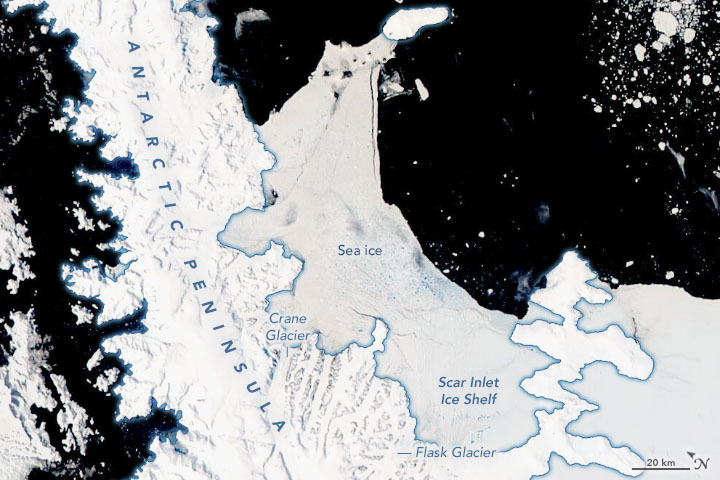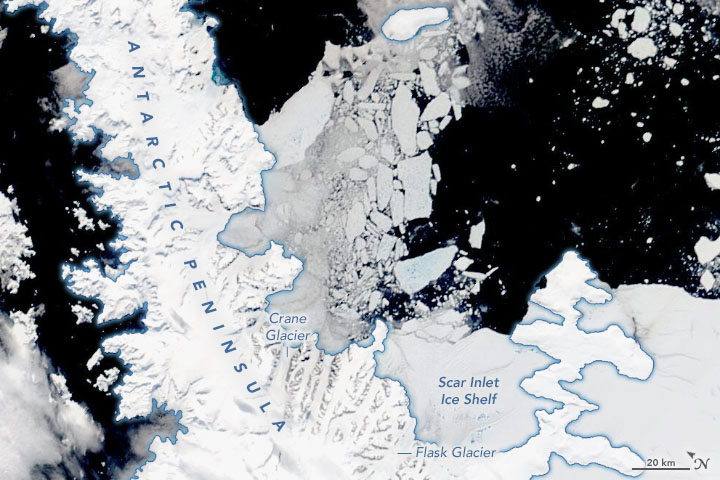

January 26, 2022
After more than a decade fastened to the coastline, a large expanse of sea ice has broken away from the Antarctic Peninsula. The ice, which had persisted in the Larsen B embayment since 2011, crumbled away over the span of a few days in January 2022, taking with it a Philadelphia-sized piece of the Scar Inlet Ice Shelf.
The Moderate Resolution Imaging Spectroradiometer (MODIS) on NASA’s Terra and Aquasatellites acquired these natural-color images of the embayment and ice shelf. The right image shows the embayment on January 26, 2022, shortly after the sea ice broke up. For comparison, the left image shows the same area on January 16, 2022.
Scientists are still investigating the reason for the breakup, but the early clearing of seasonal sea ice along the Antarctic Peninsula suggests that the austral summer has been warm and wet. Scientist Rajashree Tri Datta of University of Colorado, Boulder, noted that foehn winds, influenced by a large atmospheric river, helped destabilize the ice pack. The phenomenon is apparent in this animation composed with images from NOAA’s GEOS-16 satellite.
The breakup is the latest in a series of notable events in the Larsen B embayment over the past 20 years. Prior to 2002, glacial ice on the Antarctic Peninsula flowed toward the sea and fed into a vast floating ice shelf known as Larsen B. The shelf helped buttress inland tributary glaciers, pushing back against them and slowing their seaward flow. But in early 2002, the shelf abruptly fractured. With 3,250 square kilometers (1,250 square miles) of ice suddenly gone, glaciers thinned and flowed more quickly into the open water.
Following the collapse of Larsen B, landfast sea ice grew atop the seawater each winter and melted away entirely in most summers. But the sea ice that started to grow in late March 2011 stuck around. “It was the first time since the early 2002 shelf collapse that the Larsen B embayment was seen to freeze up and stay frozen through multiple austral summers,” said Christopher Shuman, a NASA/UMBC glaciologist. The sea ice retreated slightly at its edges during summers, and its surface occasionally became coated with blue meltwater, but the ice persisted until this January.
Satellite images of the often-cloudy region show the breakup occurred between January 19-21, 2022. Sea ice splintered and floated away from the coast, along with icebergs from the fronts of Crane Glacier and its neighbors to the north and south. Shuman thinks strong outflows of ice from the Flank and Leppard tributary glaciers likely widened a rift that led the Scar Inlet Ice Shelf—the southern remnant of the Larsen B Ice Shelf—to shed several large icebergs.
Compared to a massive ice shelf (like the original Larsen B), sea ice adjacent to land is less effective at holding back the seaward flow of glaciers, but it still plays a role. This summer’s breakup of the sea ice in the embayment is important because—unlike the meltwater from an ice shelf, icebergs, and sea ice (already floating)—the meltwater from a glacier adds to the ocean’s volume and contributes directly to sea level rise. With the sea ice now gone, “the likelihood is that backstress will be reduced on all glaciers in the Larsen B Embayment and that additional inland ice losses will be coming soon,” Shuman said.
NASA Earth Observatory images by Joshua Stevens, using MODIS data from NASA EOSDIS LANCE and GIBS/Worldview. Story by Kathryn Hansen.
No comments:
Post a Comment